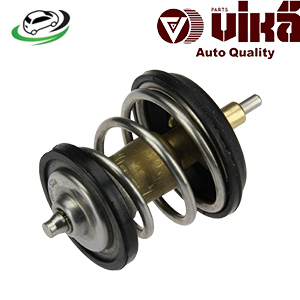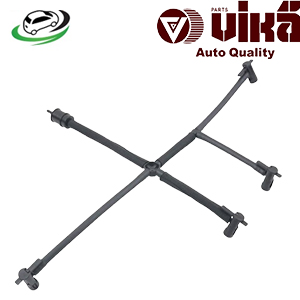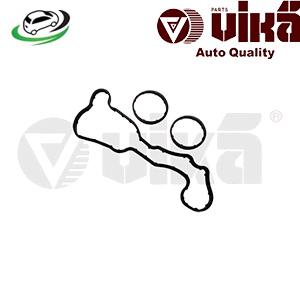-19%
Get AUDI Q7 TDI / VW Touareg 2 V6 TDI/ Touareg 3 V6 TDI Oil Cooler Gasket 059115446A
An oil cooler gasket is a specially designed sealing component located between the oil cooler and the engine block or oil cooler housing. It prevents oil and coolant from leaking out, ensuring that the fluids stay within their respective pathways. In many engines, especially those that operate under high loads or in high-temperature environments, an oil cooler is used to reduce the temperature of the engine oil. The gasket acts as a barrier to ensure that oil and coolant do not mix, maintaining the efficiency of the cooling and lubrication systems.
Primary Function of the Oil Cooler Gasket
- Sealing Fluid Pathways: The oil cooler gasket ensures that oil and coolant remain within their designated passages, preventing cross-contamination and leaks.
- Maintaining Engine Cooling: The oil cooler gasket supports the oil cooling process by preventing coolant and oil from escaping, which could compromise the engine’s cooling performance.
- Preventing Leaks: A failed gasket can cause oil or coolant leaks, which can lead to a host of issues including engine overheating, oil starvation, and eventual engine failure.
2. Components of an Oil Cooler Gasket
The oil cooler gasket is a relatively simple but essential part of the oil cooling system. Despite its small size, it is composed of durable materials that withstand the high pressure and temperature variations within the engine. Key components of the gasket include:
1. Elastomeric Material:
Most oil cooler gaskets are made from elastomeric materials such as silicone, rubber, or a composite material designed to resist the high temperatures and pressures of engine oil and coolant. The material is engineered to remain flexible and maintain its sealing properties even in harsh conditions.
2. Reinforcement Layer:
Some oil cooler gaskets incorporate a metal or fiber reinforcement layer to add strength and durability. This is particularly useful in high-performance engines where the gasket must withstand greater forces and thermal stress.
3. Precision Grooves:
Oil cooler gaskets often feature precision-molded grooves or channels to enhance sealing. These grooves help trap the fluids and ensure that the gasket fits perfectly between the mating surfaces of the oil cooler and the engine.
3. How the Oil Cooler Gasket Works
The operation of the oil cooler gasket is straightforward but essential. Its primary function is to create a leak-proof seal between the oil cooler and the engine block or housing, ensuring the proper flow of oil and coolant. Here’s how the oil cooler gasket works:
1. Sealing the Oil Cooler:
When the oil cooler is bolted to the engine block or housing, the gasket is compressed between the two surfaces. This compression forms a tight seal, preventing engine oil from leaking out of the cooler and stopping coolant from escaping from its channels.
2. Preventing Fluid Cross-Contamination:
In many vehicles, the oil cooler is a liquid-to-liquid system, meaning that engine oil is cooled by a separate coolant circuit. The oil cooler gasket ensures that oil and coolant remain isolated from each other, preventing cross-contamination. If oil and coolant mix, it can lead to engine damage, as the coolant may degrade the oil’s lubricating properties.
3. Handling Temperature and Pressure Variations:
During engine operation, the oil cooler gasket is subjected to significant temperature fluctuations and pressure changes. The gasket must maintain its sealing ability throughout the engine’s temperature cycle, preventing oil and coolant leaks regardless of the engine’s thermal conditions.
4. Types of Oil Cooler Gaskets
There are several types of oil cooler gaskets, each designed for specific engine configurations and cooling systems. The choice of gasket depends on the engine design, the type of oil cooler, and the operating conditions. Common types include:
1. Rubber Gaskets:
Rubber gaskets are widely used in standard vehicles due to their flexibility and durability. They are cost-effective and offer sufficient sealing capabilities for most everyday driving conditions. Rubber gaskets are typically made from high-temperature silicone or nitrile rubber, which can withstand heat and pressure.
2. Composite Gaskets:
Composite gaskets combine multiple materials, such as metal, rubber, and fiber, to enhance strength and durability. These gaskets are often used in high-performance vehicles where extreme temperatures and pressures are common. The combination of materials offers a balance of flexibility and strength.
3. Metal Reinforced Gaskets:
Metal-reinforced gaskets feature a thin layer of metal embedded within the elastomeric material. This reinforcement adds structural strength, making the gasket more resistant to deformation under high pressure. Metal-reinforced gaskets are often found in heavy-duty engines, such as trucks or high-performance vehicles.
4. Molded Rubber Gaskets:
Molded rubber gaskets are custom-shaped to fit specific oil cooler configurations. These gaskets provide excellent sealing and are often used in applications where the mating surfaces are irregular or have complex geometries.
5. Benefits of a Properly Functioning Oil Cooler Gasket
A properly functioning oil cooler gasket is critical for maintaining the performance and longevity of the engine. Here are the key benefits of a well-maintained gasket:
1. Leak Prevention:
The primary benefit of a properly functioning oil cooler gasket is its ability to prevent oil and coolant leaks. By maintaining a tight seal, the gasket ensures that engine oil and coolant remain in their respective systems, preventing fluid loss and potential engine damage.
2. Engine Cooling Efficiency:
By preventing coolant leaks, the oil cooler gasket helps maintain the efficiency of the engine’s cooling system. Without proper sealing, coolant loss could lead to overheating, which can cause significant engine damage.
3. Improved Lubrication:
A sealed oil cooler ensures that engine oil remains at the proper temperature, which is critical for maintaining optimal lubrication. Cool oil is more effective at reducing friction and wear on engine components, leading to improved engine performance and longevity.
4. Extended Engine Lifespan:
By preventing oil and coolant leaks, the oil cooler gasket helps protect the engine from overheating, oil starvation, and fluid contamination. This extends the lifespan of the engine and reduces the likelihood of expensive repairs.
6. Common Issues with Oil Cooler Gaskets
Like any gasket, the oil cooler gasket is subject to wear and tear over time. Some of the most common issues include:
1. Oil Leaks:
A deteriorating oil cooler gasket may allow oil to leak from the cooler. Oil leaks can reduce the amount of lubricant available to the engine, increasing friction and wear on internal components.
2. Coolant Leaks:
A failing gasket may also lead to coolant leaks, reducing the effectiveness of the engine’s cooling system. Coolant leaks can cause the engine to overheat, leading to serious damage such as a blown head gasket or warped cylinder heads.
3. Fluid Contamination:
If the oil cooler gasket fails, coolant and oil may mix, resulting in contamination. Oil contaminated with coolant can lose its lubricating properties, while coolant contaminated with oil can cause cooling system blockages.
4. Gasket Deterioration:
Over time, exposure to high temperatures, pressure fluctuations, and chemical reactions can cause the gasket material to break down. This can lead to cracks, shrinkage, or hardening, reducing the gasket’s sealing effectiveness.
7. Oil Cooler Gasket Maintenance and Replacement
Maintaining the oil cooler gasket is essential for preventing leaks and ensuring the longevity of the engine. Here are some maintenance tips and information on replacement:
Signs of a Failing Oil Cooler Gasket:
- Visible oil or coolant leaks around the oil cooler or engine block.
- Engine overheating due to coolant loss.
- Low oil levels or contaminated oil.
- A persistent burning oil smell.
Replacing the Oil Cooler Gasket:
Replacing an oil cooler gasket is typically a straightforward process but should be performed by a professional mechanic. The steps involved in gasket replacement include:
- Draining the engine oil and coolant.
- Removing the oil cooler from the engine block.
- Cleaning the mating surfaces of the engine block and oil cooler.
- Installing the new gasket and resecuring the oil cooler.
- Refilling the engine with fresh oil and coolant.
Regular inspection and timely replacement of the oil cooler gasket are critical for preventing engine damage.
8. Conclusion
The oil cooler gasket may be a small and often overlooked component, but its role in maintaining engine integrity is immense. By ensuring that engine oil and coolant remain in their proper channels, the gasket helps keep the engine lubricated and cool, preventing overheating, fluid contamination, and leaks. Regular inspection and maintenance of the oil cooler gasket are essential for optimal engine performance, longevity, and cost-effective vehicle operation. A well-functioning oil cooler gasket is crucial to the overall health of the engine’s cooling and lubrication systems.
Follow us on Facebook for more parts.




Reviews
Clear filtersThere are no reviews yet.